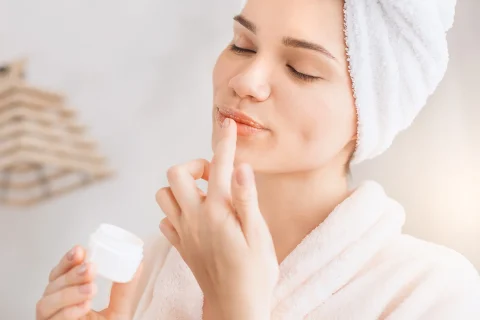Many materials make up lip fillers, each offering distinct results and lifespans. Discover which is right for you.
Lip fillers utilize diverse substances. Hyaluronic acid, a naturally occurring compound, and synthetic versions are common choices. Collagen, calcium hydroxylapatite, and fat transfers are also employed. Each material yields varying aesthetic outcomes and longevity.
Hyaluronic acid fillers, for example, typically last 6 to 12 months, while collagen’s effects may dissipate more quickly. Different substances might produce subtly different results, and individuals may respond differently to various filler types.
Hyaluronic Acid: A Natural Plumper

Hyaluronic acid fillers utilize a naturally occurring substance in your skin. This hydrophilic molecule actively attracts and binds water, significantly plumping the lips.
This hydrating effect volumizes and smooths lips, offering a subtle enhancement. Common brands leverage this natural substance to craft effective fillers that mimic your body’s own materials, potentially minimizing adverse reactions.
Results, often lasting several months, create a natural-looking lip enhancement for volumizing, contouring, or reshaping. You’ll likely experience a noticeable, temporary boost in lip hydration.
Synthetic Hyaluronic Acid: Mimicking Nature
Synthetic hyaluronic acid duplicates the natural substance in your body. This lab-created form is engineered for biocompatibility, making it generally well-tolerated by tissues.
Its unique molecular structure allows it to absorb and hold substantial amounts of water, effectively plumping and volumizing areas. Initial results, like fuller lips, are visible within two to four weeks as the filler settles.
Sustained support of lip tissue and smoothing of wrinkles may last for six to eighteen months, potentially correcting asymmetries.
Hyaluronic acid’s reversible nature, broken down by hyaluronidase injections, offers flexibility and minimizes potential long-term effects.
This biocompatible material, used in popular fillers like Juvéderm and Restylane, consistently delivers noticeable results.
Other Materials Used in Lip Fillers
Beyond hyaluronic acid, lip filler procedures utilize diverse materials.
Fat transfers, harvesting and injecting a patient’s own fat cells, can yield lasting results but are more invasive than hyaluronic acid fillers.
Collagen stimulation methods, such as calcium hydroxylapatite, stimulate collagen production. However, their thicker consistency makes them less effective for achieving subtle lip augmentation.
Poly-L-lactic acid, another biocompatible material, similarly encourages collagen production but is primarily used for broader facial volume restoration.
Autologous materials, including fat transfers and dermal grafts, utilize the patient’s own tissues, minimizing allergic reactions; however, they may require multiple treatments, potentially with surgical procedures, and result in variable outcomes.
Collagen-Based Fillers: Derived From Animals
Collagen-based fillers, derived from bovine or porcine sources, or synthesized, were early cosmetic fillers.
These initial formulations, often using animal collagen, can pose biocompatibility concerns.
Synthetic alternatives aim to mitigate allergic reactions, though animal-derived collagen still presents a source.
Choosing the collagen source significantly impacts filler safety.
These fillers volumize but generally offer a limited lifespan, typically lasting several months.
Synthetic Calcium Hydroxylapatite: Smoothing and Filling
Calcium hydroxylapatite fillers effectively smooth and fill facial features. These fillers, derived from a mineral-like compound, are biosynthetically produced, potentially minimizing allergic reactions.
Their calcium composition and biocompatibility make them safe for injection. This formulation, featuring calcium-based microspheres suspended in a water-based gel, rapidly provides volume. The microspheres act as a scaffold, which may stimulate collagen growth, contributing to long-lasting volume and elasticity.
The particles naturally dissolve, preventing migration and yielding a natural appearance. These fillers effectively address moderate-to-severe facial creases and enhance facial contours.
Results can last for up to 18 months or longer, and the quick procedure typically requires no downtime.
Poly-L-lactic Acid: Stimulating Collagen Production

Poly-L-lactic acid (PLLA) differs from calcium hydroxylapatite fillers by stimulating your body’s collagen production. This biocompatible polymer triggers a controlled inflammatory response, prompting your body to build new collagen, a key benefit.
PLLA microparticles gradually break down over several months, encouraging fibroblast growth and more collagen production. This process leads to a gradual increase in volume and tissue rejuvenation.
Optimal results typically require multiple treatments spaced several months apart. The gradual collagen stimulation may result in long-lasting volume augmentation and noticeable improvements in facial contours, including smoothing lines and filling depressions.
PLLA may also enhance lip fullness and revitalize the lower face, potentially improving skin elasticity.
Polymethylmethacrylate (PMMA): Permanent or Semi-Permanent Option
PMMA fillers, often categorized as a semi-permanent choice, work by injecting microspheres into the desired area.
These tiny spheres, measuring 30 to 120 micrometers in diameter, are large enough to resist breakdown by the body’s immune system. This durability may yield results lasting up to five years.
The filler material remains at the injection site, stimulating collagen production by cells called fibroblasts. This newly formed collagen matrix supports the volume increase, contributing to the filler’s semi-permanent nature.
Crucially, PMMA is non-biodegradable, meaning it won’t naturally break down within the body. This unchanging composition is a key aspect of PMMA’s long-term presence.
Silicone: Another Synthetic Fillers Material
Silicone, another synthetic filler, stands in sharp contrast to semi-permanent options like PMMA.
Injectable silicone for cosmetic purposes carries substantial risks. It isn’t FDA-approved for this use. Often, non-medical-grade industrial silicone, potentially mixed with harmful substances, is injected—a dangerous practice frequently performed by unqualified practitioners.
This can result in complications like tissue death, migration, and scarring. Unlicensed injections dramatically increase the likelihood of serious health problems.
Prioritize practitioners with the appropriate qualifications and seek out FDA-approved, medical-grade fillers. The potential consequences of choosing otherwise are severe.
Using injectable silicone carries considerable health risks.
Characteristics of Hyaluronic Acid Fillers
Hyaluronic acid (HA) fillers differ significantly from silicone fillers. They exhibit various rheological properties, including differing storage and viscous moduli, which directly influence their firmness and flow.
HA’s key biocompatibility is critical. Its hydrophilic nature allows it to attract and retain water, contributing to volume enhancement.
HA products vary in molecular weight and crosslinking, impacting longevity and firmness. Manufacturing processes significantly affect rheological properties and stability.
Sterilization methods also play a role in maintaining product integrity. HA concentration can alter the final result.
HA fillers generally have high biocompatibility, minimizing the need for skin testing. Different HA filler types offer varying durations, with some lasting up to a year or more.
Safety and Potential Side Effects

Lip fillers, while generally safe, can cause various side effects. Common reactions include swelling, bruising, redness, tenderness, minor bleeding, and itchiness around the lips.
Discoloration, often appearing bluish, is also possible. More serious, though infrequent, side effects may include prolonged swelling or bruising lasting several days, lip asymmetry, lumps, or infections.
Vascular occlusion, potentially leading to tissue loss, is another concern. Allergic reactions, ranging from localized discomfort and rash to systemic responses involving breathing difficulties, are possibilities.
Proper safety protocols and post-procedure care are critical. Other potential complications include cold sore reactivation, skin eruptions, and injection site issues such as pain, warmth, or discharge.
Understanding these potential side effects is vital for making an informed decision about lip filler procedures.










